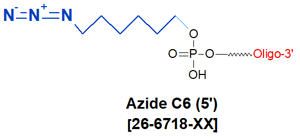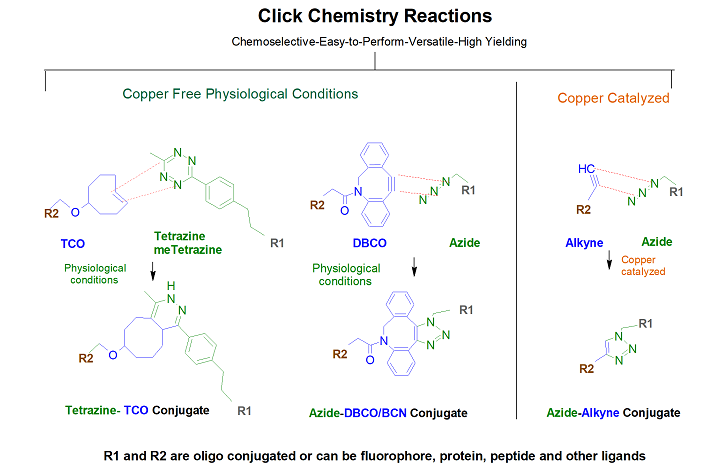
Modification : Azide C6 (5')
Catalog Reference Number
Category
Modification Code
5 Prime
3 Prime
Internal
Molecular Weight (mw)
Extinction Coeficient (ec)
Technical Info (pdf)
Absorbance MAX
Emission MAX
Absorbance EC
26-6718
Click Chemistry
[N3-C6-5]
Y
N
N
205.15
-
26-6718.pdf
-
-
-
| Catalog No | Scale | Price |
| 26-6718-05 | 50 nmol | $194.00 |
| 26-6718-02 | 200 nmol | $194.00 |
| 26-6718-01 | 1 umol | $270.00 |
| 26-6718-03 | 2 umol | $335.00 |
| 26-6718-06 | 5 umol | $905.00 |
| 26-6718-10 | 10 umol | $1,432.00 |
| 26-6718-15 | 15 umol | $1,790.00 |
| Discounts are available for Azide C6 (5')! |
| Modification* Discount Price Structure |
|
1 site/order
|
List price
|
|
2 sites/order
|
10% discount
|
|
3 sites/order
|
20% discount
|
|
4 sites/order
|
30% discount
|
|
5-9 sites/order
|
50% discount
|
|
10+ sites/order
|
60% discount
|
|
*Exceptions apply
|
Copper-free Click Chemistry Modifications
Use azide modified oligos with DBCO Cyclooctyne-based modifications for ease of copper-free click reagents. These are simple to use and has excellent click performance in 17 hours or less at room temperature. Gene Link offers 5'-DBCO-TEG for preparing oligos with 5’-DBCO and a 15 tom triethylene glycol spacer arm, DBCO-dT for inserting a DBCO group at any position within the oligonucleotide and DBCO-sulfo-NHS Ester is also offered for post-synthesis conjugation reactions. DBCO-modified oligos may be conjugated with azides in organic solvents, such as DMSO, or aqeous buffers. Depending on the azide used, the reaction will go to completion in 4-17 hours at room temperature.
Azide C3 is available to introduce a stable azide group at the 3' of an oligo. Use Azide butyrate NHS [26-6922] for introduction of azide at internal or 5' position by conjugating to an amino-modified oligonucleotide. Introduction can be done at either the 5'- or 3'-end, or internally. To do this, the oligo first must be synthesized with a primary amino functional group modification, e.g Amino C6 for the 5' end or amino C7 for the 3' end for the ends) or the amino C6 version of the base phosphoramidite (for internal labeling). The Azidobutyrate NHS ester is then manually attached to the oligo through the amino group in a separate reaction post-synthesis.
The presence of the azide allows the user to use "Click Chemistry" (a [3+2] cycloaddition reaction between alkynes and azides, using copper (I) iodide as a catalyst) to conjugate the azide-modified oligo to a terminal alkyne-modified oligo with extremely high regioselectivity and efficiency (1,2). Preparation of the alkyne-modified oligo can be achieved using the 5’-Hexynyl modifier (see its respective tech sheet for details). Click chemistry can be used to form short, cyclic oligos that can be used as research tools in various biophysical and biological studies (3). In particular, they have considerable potential for in vivo work, as cyclic oligos are known to be very stable in serum for up to several days.
 References
References
1. Huisgen, R.
Angew. Chem. Int. Ed. (1963),
2]: 565-568.
2. Rostovtsev, V.V., Green, L.G., Fokin, V.V., Sharpless, K.B. A Stepwise Huisgen Cycloaddition Process: Copper(I)-Catalyzed Regioselective Ligation of Azides and Terminal Alkynes.
Angew. Chem. Int. Ed. (2002),
41: 2596-2599.
3. Kumar, R., El-Sagheer, A., Tumpane, J., Lincoln, P., Wilhelmsson, L.M., Brown, T. Template-Directed Oligonucleotide Strand Ligation, Covalent Intramolecular DNA Circularization and Catenation Using Click Chemistry.
J. Am. Chem. Soc. (2007),
129: 6859-6864.
- Azide C6 (5')
